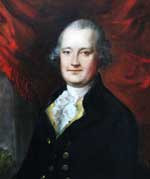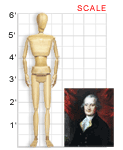VAM galleries including this work:
The Kentucky Derby Museum | Go Figure || VAM Home
Gainsborough Dupont (English, 1754-1797)
EDWARD, 12TH EARL OF DERBY (1752-1834), date unknown
Oil on canvas; 29-3/4" X 24-7/8"
Donated by Millard Cox III, 1998.2.
The Kentucky Derby Museum
This portrait was originally attributed to the famous artist Thomas Gainsborough, Gainsborough Dupont’s uncle and mentor. With further study, H.G. Belsey, the curator of the Gainsborough House in Sudbury, England, determined that the decorative style of the painting was much closer to that of Dupont. The sitter is Edward Smith Stanley, 12th Earl of Derby, who created the Epsom Derby and Epsom Oaks in England. These 1½ mile races for 3-year-old thoroughbreds served as the models for the Kentucky Derby and Kentucky Oaks, which have been run annually at Churchill Downs since 1875.
About the Artist
Gainsborough Dupont was born in England in 1754. The nephew of artist Thomas Gainsborough (1727-1788), Dupont moved to Bath to apprentice with Gainsborough in 1772. Dupont’s subject matter included landscapes, but he is remembered most for his portraits of society and theater people. Rejected by the Royal Academy on more than one occasion, Dupont was never able to achieve the recognition enjoyed by his famous uncle. He eventually gave up his career as an artist and became the director of the French Protestant Hospital. Upon his death in 1797, Dupont was buried near his uncle in Kew Churchyard in England.
Classroom Ideas
Discussion: Who would be likely to have a portrait painted of him or herself? Why would she/he want it done? Compare and contrast several portraits executed in roughly the same period—for example, the portraits of George IV and Colonel Joseph Hamilton Daveiss in the Owensboro Museum of Fine Art. Or visit the National Portrait Gallery and find portraits there that were painted during the 18th century. What do these pictures depict? Do they appear to be more realistic or flattering? Why would the artists paint them this way? Powerful people have always been concerned with their image, and their portraits have traditionally been painted to impress and illustrate the subject’s importance.
Activities: Think about the reasons a person might have a portrait painted. Do you know anyone that fits these criteria? Have this person sit for a portrait if he or she is willing and able. If not, you can use a photograph to render his or her likeness. Think about how you want to portray this person as you work.
As an alternative, pair up with another student and create portraits of each other. Decide in advance what image of yourself you would like conveyed in your portrait. Then challenge your partner to paint your portrait so that this image is conveyed to the viewer.
Links
Learn more about Gainsborough Dupont and view several of his works at the National Gallery of Art.
[www.nga.gov/cgi-bin/psearch?Request=S&imageset=1&Person=233610]
Visit the National Portrait Gallery for a wide range of portraits and excellent ideas for the classroom.
[www.npg.si.edu]
Learn more about the life and work of Dupont’s uncle and mentor, Thomas Gainsborough, at Artchive.
[www.artchive.com/artchive/G/gainsborough.html]
This portrait of Dupont from Olga’s Gallery was painted by his famous uncle.
[www.abcgallery.com/G/gainsborough/gainsborough56.html]
The Edsitement web site (Marco Polo) contains an excellent lesson plan on portraits.
[edsitement.neh.gov/view_lesson_plan.asp?id=270]

